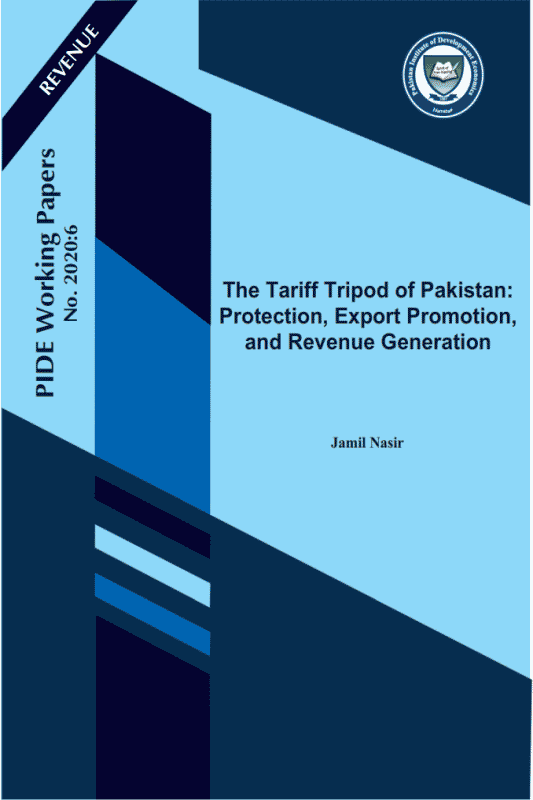
Pakistan Institute of Development Economics
- Home
Our Portals
MenuMenuMenuMenuMenuMenuMenu - ResearchMenuMenuMenuMenuMenuMenuMenu
- Discourse
- The PDR
- Our Researchers
- Academics
- Degree Verification
- Thesis Portal
- Our Portals
The Tariff Tripod of Pakistan: Protection, Export Promotion, and Revenue Generation (PIDE Working Papers No. 2020:6)
This paper gives an overview of tariff structure of Pakistan. The protection of local industry, export promotion and revenue generation constitute the triangular tripod of Pakistan tariff. The said three objectives are achieved mainly through imposition of high tariffs on output goods (protection of local industry), duty- exemption schemes and SROs for exporters (export promotion), and multiple levies at import stage on tariff-inclusive price (revenue generation). About half of the revenue of FBR is collected from imports. Protection to sectors like auto and textile is high and consumer welfare is totally missing from the entire scheme of tariff. Despite high protection and multiple export promotion schemes, local manufacturing is weak and exports are stagnant. The revenue has, however, increased manifold over the years and interestingly revenue witnessed big upward jump when MFN rates of tariff fell. Revenue generation is the major consideration in tariff setting. Tariffs are set as an exercise in accounting with the assumption that rates and revenue have got a positive linear relationship. Income effect, substitution effect and volume effect hardly enter into the mental calculations of tariff setters. Due to high incidence of taxes at import stage, incentives for smuggling, under- invoicing, misdeclaration, and evasion are high. Smuggling is rampant and hard to control due to peculiar geographic situation of Pakistan. Under-invoicing is clear from the trade gap between China and Pakistan. As regards misdeclaration, evasion and corruption at ports, I calculate a hypothetical value of CD based on TWA and CEF for the period 1997-98 to 2018-19. These calculations provide interesting policy insights. First, evasion through misdeclaration is high when tariff rates are high and evasion goes down in percentage terms with reduction in tariff rates. Second, CEF increases as a result of reforms in Customs like simplification and automation of clearance processes and procedures. After detailed discussion, paper suggests that protection provided to the local industry should be time-bound with clear sunset date and accountability against rent -seeking. Based on cap-cape equation, paper further suggests that exemptions and concessions in import duties should preferably be provided through tariff code and not through SROs and difficult-to-use exportoriented schemes. In order to put the country on the trajectory of long term growth, import tariffs on input goods and machinery should be phased out in the short to medium term and instead of relying on increase in tariff rates and imposition of additional levies on imports, better policy option is to enhance CEF through reforms aimed at risk based automated clearances.



